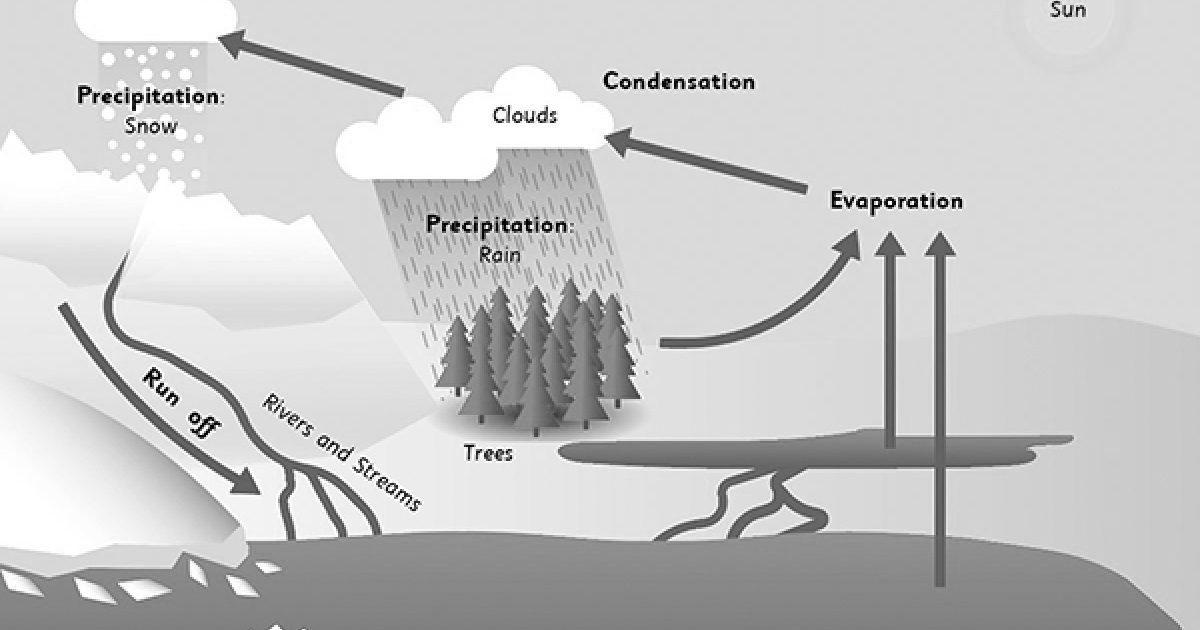
Draw a neat and labeled diagram of the water cycle in nature.
Answer
545.1k+ views
Hint: There is a continuous circulation of water, between the various levels such as the ground, water bodies as well as the atmosphere. In this process, the circulating water changes its state. The process is also known as the hydrologic cycle.
Complete answer:
The water- cycle involves several steps:

Evaporation: This is the first step involved in the water cycle. The water present in water bodies such as rivers, lakes, or oceans due to the heat of the sun gets evaporated and gets converted to water vapor and rises. Since the weight of these vapors is less, these can rise to a height. Another method which contributes to evaporation is the process of transpiration, whereby water is lost in the form of vapor through the stomata of the leaves.
Condensation: During the next step, the water vapor which has risen to a height, due to a decreased temperature, gets condensed to form water droplets. This process is responsible for the formation of clouds.
Precipitation: Due to continuous condensation, the size of the clouds formed grows bigger, wherein they collide with each other and thus results in precipitation. It can occur in various forms such as rain, hail, or snow.
Runoff: When the amount of precipitation increases, the fallen water runs off. The water thus forms a stream and joins rivers and seas which are the larger water bodies.
This cycle continues with the ran off water from the oceans evaporating.
Note: Apart from the water cycle, there are many other cycles involved in the atmosphere. These are known as the biogeochemical cycles. Examples of various biogeochemical cycles are the Carbon cycle, nitrogen cycle and oxygen cycle.
Complete answer:
The water- cycle involves several steps:

Evaporation: This is the first step involved in the water cycle. The water present in water bodies such as rivers, lakes, or oceans due to the heat of the sun gets evaporated and gets converted to water vapor and rises. Since the weight of these vapors is less, these can rise to a height. Another method which contributes to evaporation is the process of transpiration, whereby water is lost in the form of vapor through the stomata of the leaves.
Condensation: During the next step, the water vapor which has risen to a height, due to a decreased temperature, gets condensed to form water droplets. This process is responsible for the formation of clouds.
Precipitation: Due to continuous condensation, the size of the clouds formed grows bigger, wherein they collide with each other and thus results in precipitation. It can occur in various forms such as rain, hail, or snow.
Runoff: When the amount of precipitation increases, the fallen water runs off. The water thus forms a stream and joins rivers and seas which are the larger water bodies.
This cycle continues with the ran off water from the oceans evaporating.
Note: Apart from the water cycle, there are many other cycles involved in the atmosphere. These are known as the biogeochemical cycles. Examples of various biogeochemical cycles are the Carbon cycle, nitrogen cycle and oxygen cycle.
Recently Updated Pages
Master Class 12 English: Engaging Questions & Answers for Success

Master Class 12 Social Science: Engaging Questions & Answers for Success

Master Class 12 Chemistry: Engaging Questions & Answers for Success

Which is the Longest Railway Platform in the world?

India Manned Space Mission Launch Target Month and Year 2025 Update

Which of the following pairs is correct?

Trending doubts
What are the major means of transport Explain each class 12 social science CBSE

Which are the Top 10 Largest Countries of the World?

Draw a labelled sketch of the human eye class 12 physics CBSE

How much time does it take to bleed after eating p class 12 biology CBSE

Explain sex determination in humans with line diag class 12 biology CBSE

Plot a graph between potential difference V and current class 12 physics CBSE




